

















Inside: Can AI transform food systems? | Water-use efficiency in agriculture | Revolutionising food security | SMALL-scale farming



















CHEP is a global leader in supply chain solutions, specialising in pallet and container pooling services. With operations in over 60 countries and across various industries, CHEP manages, maintains, transports and supplies approximately 347 million pallets, crates and containers globally. By facilitating sharing and reuse among growers, manufacturers, distributors and retailers, CHEP minimises waste and emissions, contributing to industry-wide sustainability efforts. With a focus on optimising supply chains and profitability, CHEP empowers businesses to use higher-quality platforms, reduce transportation costs and attain standardisation efficiencies. Through its share and reuse model,
CHEP delivers more goods to more people in more places than any other organisation.
Sustainability is integral to CHEP’s approach, actively contributing to the restoration of natural systems and positively impacting local communities and the broader economy. As part of the Brambles Group, CHEP’s leadership in sustainability gained further recognition during the year, with TIME Magazine ranking the company #4 in its inaugural list of the world’s most sustainable companies. The company was also named 2nd most sustainable corporation in the world by Corporate Knights in 2024 and retained the top ranking in its industry category in the 2023 Dow Jones Sustainability Index.
www.chep.com
The SPAR Group Ltd is a warehousing and distribution business listed on the Johannesburg Stock Exchange in the Food and Drug Retailers sector. The group owns the SPAR retail brand, but, essentially, supports a network of independent retailers trading under the brand through the group’s distribution centres.
SPAR forms part of SPAR International, which is present in 44 countries and has 240 distribution centres serving 13 million customers every day. The SPAR Group Ltd, headquartered in Durban, South Africa, is present in 9 countries, has 10 distribution centres and serves 3 768 retail members through 14 different store formats daily.
BY
Picasso Headline,
A proud division of Arena Holdings (Pty) Ltd, Hill on Empire, 16 Empire Road (cnr Hillside Road), Parktown, Johannesburg, 2193 PO Box 12500, Mill Street, Cape Town, 8010 www.businessmediamags.co.za
Editor: Elriza Theron
Content Manager: Raina Julies rainaj@picasso.co.za
Contributors: Chantel Arendse, Lindi Botha, Colleen Dardagan, Sakhile Dube, Magda du Toit Kimberly Mutandiro, Maseo Freddy Nethanani, Wandile Sihlobo
Copy Editor: Brenda Bryden
Content Co-ordinator: Natasha Maneveldt
Online Editor: Stacey Visser vissers@businessmediamags.co.za
Head of Design: Jayne Macé-Ferguson
Senior Designer: Mfundo Archie Ndzo
Advert Designer: Zainab Aboo
Cover Images: Istockphoto.com, supplied
Project Manager: Jerome van der Merwe Jeromem@picasso.co.za | +27 21 469 2485 +27 820 668 1496
Sales: Frank Simons
Production Editor: Shamiela Brenner
Advertising Co-ordinator: Johan Labuschagne
Subscriptions and Distribution: Fatima Dramat, fatimad@picasso.co.za
Printer: CTP Printers, Cape Town
Management Accountant: Deidre Musha
Business Manager: Lodewyk van der Walt
General Manager, Magazines: Jocelyne Bayer

Copyright: Picasso Headline. No portion of this magazine may be reproduced in any form without written consent of the publisher. The publisher is not responsible for unsolicited material. World Food Day is published by Picasso Headline. The opinions expressed are not necessarily those of Picasso Headline. All advertisements/advertorials have been paid for and therefore do not carry any endorsement by the publisher.
Food security. Do we ever stop to think what that really means? When we are loading our trollies or baskets at a supermarket or ordering from a restaurant or buying a quick hunger gap ller from a vendor – every time we engage in an activity that provides us with this basic requirement for life, we become part of a very intricate system.
Agriculture is much more than just food production on a farm; it involves strenuous research and development and meticulous project management from input manufacturing to exporting our proudly South African products. At each step are people whose livelihoods depend on this system to provide for themselves and their families, and the exponential effect of this industry in terms of job creation, investment in infrastructure and, of course, providing nourishment to all South Africans should be celebrated.
Recent events have shown how fragile food systems can become if trade routes or supply chains are disrupted for whatever reason, be it climate events, war or trade disputes. It reaf rms how valuable food security, and perhaps more importantly, food sovereignty, is for a country’s stability. Few industries have shown such remarkable resilience as South African agriculture, with the annual growth rate of the industry exceeding the overall growth rate of the economy by a third, according to the Bureau for Food and Agricultural Policy’s Baseline Report 2024. And so, in honour of World Food Day, let us take a moment to celebrate those responsible for getting food to our tables while using the opportunity to educate ourselves about the numerous aspects of food production that we may often take for granted.
Elriza Theron Editor
6 SUSTAINABILITY
Meaningful transformation in food systems: recommendations from the B20 Sustainable Food Systems and Agriculture Task Force.
10 SUSTAINABLE
The sustainable agriculture and ESG landscape is complex, but all areas of agriculture are committed to sustainable practices and meeting environmental, social and governance requirements.
12 AGRICULTURE
What can we learn from South Africa’s agricultural growth story?
17 AGRITECH
Can digital technologies and AI transform food systems globally?
20 SMALL-SCALE
Creating healthier communities through farming.
24 FOOD SYSTEMS
A closer look at South Africa’s food system.

25
Healthy soil is a key driver of farm productivity, pro ts and sustainable food production.
28 FOOD
Nothing beats potatoes for best resource use and food security.
33
Contributions of genome editing towards improving food security and sustainability.
35 WATER SECURITY
Water-use ef ciency in agriculture.
36 WATER EFFICIENCY
How to create a water-ef cient vegetable garden.
As we mark World Food Day, it’s a powerful reminder of the ongoing need to address hunger and malnutrition, especially among the most vulnerable members of society: our children. By CHEP
In South Africa, statistics from the Do More Foundation’s research reveal that nearly 60 per cent of children under six live in poverty, with 12 per cent experiencing hunger and 27 per cent suffering from stunting due to chronic malnutrition.
These statistics are not just numbers; they represent a generation at risk. Stunting, characterised by a child being signi cantly shorter than their peers due to malnutrition, is more than a physical condition; it signals poor cognitive development. By age two, stunting is the single most signi cant predictor of an individual’s economic potential as an adult.
With 90 per cent of brain growth and development occurring by age ve, inadequate nutrition during these formative years can trap children in a cycle of poverty, denying them the future they deserve.
CHEP, a global leader in supply chain solutions, in collaboration with the Do More Foundation (founded by RCL FOODS), is tackling this crisis head-on with the Do More Foundation’s national porridge initiative. This programme is about more than just feeding children; it’s about giving them a ghting chance for a better life. By providing a specially formulated, nutrient-rich porridge to thousands of Early Childhood Development (ECD) programmes across the country, this initiative ensures that children receive the vital nutrition they need during their most critical years of development.
Created with input from a public health and nutrition consultant, the porridge is packed with essential vitamins and minerals necessary for proper brain development, growth and overall health and meets the nutritional needs of young children aged three to ve years.
In many of the communities where this porridge is distributed, it is often the only meal children receive in a day. Understanding this,
the programme extends its reach beyond the school term. During school holidays, when the risk of hunger increases, children are sent home with porridge packs, ensuring they continue to receive the nutrition.
Marietjie Brown, Sustainability and Government Affairs Lead for CHEP India, Middle East, Türkiye and Africa, says: “Through our collaboration with the Do More Foundation, we’re not just providing a meal; we’re empowering a generation. By focusing on early childhood nutrition, we’re laying the groundwork for future leaders and innovators. Each bowl of porridge represents more than sustenance – it’s a commitment to breaking the cycle of poverty and fostering a generation that can drive positive change in their communities and beyond. Together, we’re investing in the potential of every child, ensuring they have the tools to build a brighter future for themselves and their world.”
This initiative aligns seamlessly with CHEP’s commitment to sustainability and the global community’s Sustainable Development Goals (SDGs). One of CHEP’s 2025 sustainability goals is food security, directly supporting SDG 2: Zero Hunger. The programme’s focus on reducing hunger and malnutrition among children also ties into SDG 3: Good Health and Wellbeing, and SDG 4: Quality Education, by setting the stage for healthier, more educated future generations.
CHEP’s involvement in this initiative is deeply rooted in its corporate social responsibility strategy, which focuses on making a positive impact for the communities within which it operates. As part of this commitment, CHEP funds the distribution of porridge to schools in the Weatherboard and Braecroft areas –

regions surrounding CHEP’s timber farms and sawmill. These areas are home to some of the most vulnerable populations, making the need for nutritional support important and urgent.
The success of the porridge initiative underscores the power of collaboration. By working together, resources are more proactive and used ef ciently, and the programme’s impact is maximised. Over the past year, CHEP and the Do More Foundation have distributed more than 330 800 porridge meals targeting ECDs across two provinces. This effort has delivered 16 544.5kg of porridge to 495 young children, making a meaningful difference in their lives.
CHEP’s parent company, Brambles, has a long-standing commitment to supporting food banks and addressing food insecurity on a global scale. As part of its 2025 sustainability targets, Brambles has pledged to collaborate with food banks to serve rescued food to 10 million people per year – a target already surpassed, with 19.7 million people reached in the past nancial year alone.
Its Food Positive objective is aligned directly with SDG 2: Zero Hunger and SDG 12:

Responsible Consumption and Production. Through partnerships with global food banks, such as the Global FoodBanking Network, the company plays a crucial role in reducing food waste and redistributing surplus food to those most in need.
As we re ect on the signi cance of World Food Day, it’s clear that initiatives such as the porridge programme are essential for addressing the deep-rooted issues of hunger and malnutrition
in South Africa. CHEP, in partnership with the Do More Foundation, is making a tangible difference in the lives of thousands of children, giving them the nourishment they need to grow, learn and thrive.
However, the ght against hunger and malnutrition requires collective action. We invite businesses, organisations and individuals to join us in this critical mission. Together, we can ensure that every child in South Africa has the opportunity to reach their full potential, breaking the cycle of poverty and building a brighter future for all.

to go to the CHEP website
If you would like to partner with CHEP or the Do More Foundation, please connect with us on:
CHEP: za-info@chep.com Do More Foundation: support@domore.org.za www.chep.com
Meaningful transformation in food systems with recommendations from the B20 Sustainable Food Systems and Agriculture Task Force.
By ELRIZA THERON
The G20, or Group of Twenty, represents a group of countries with the largest economies that convene annually at the G20 Summit to discuss matters pertaining to economic, political and social initiatives. According to its website, the member states currently comprise 19 sovereign countries, the African Union and the European Union. These represent around two-thirds of the world’s population and around 75 per cent of international trade. Usually, these summits are attended by the heads of state, nance and foreign ministries and other high-ranking of cials. In addition, various other international organisations, such as the International Monetary Fund, The Food and Agriculture Organization of the United Nations, The World Trade Organization and UNESCO, are also invited to participate.
This year the summit is hosted in Brazil, with South Africa next in line to host in 2025.
The Business 20 (B20) connects the business community with G20 governments and it comprises various task forces. One of these is the Sustainable Food Systems and Agriculture Task Force, which has been tasked with developing an agenda to address the most complex and challenging issues of food systems today. These challenges are numerous, sometimes seeming insurmountable, however, agriculture at its core is based on innovation and resilience, and collectively it is possible to develop robust and sustainable solutions to these challenges.
THE SUSTAINABLE FOOD SYSTEMS AND AGRICULTURE TASK FORCE HAS BEEN TASKED WITH DEVELOPING AN AGENDA AIMED AT ADDRESSING THE MOST COMPLEX AND CHALLENGING ISSUES OF FOOD SYSTEMS TODAY.
Food systems today are complex and quite impressive feats of human ingenuity. The B20 Brazil Sustainable Food Systems and Agriculture Policy Paper states that globally 10 per cent of gross domestic and 35 per cent of jobs are within the food system, while 18 per cent of global commodities traded are within the agricultural sector. Despite this, we still grapple with the challenge of 2.4 billion people facing moderate to severe food insecurity, according to the 2023 State of Food Security and Nutrition in the World report. In addition, along with agriculture’s impressive growth and contribution to feeding the growing population, it faces sustainability-related issues, such as its contribution to greenhouse gas emissions, that will need to be addressed through innovation. For this reason, the Sustainable Food Systems and Agriculture Task Force developed three recommendations in the journey towards more meaningful and sustainable food systems.

The rst recommendation is to enhance productivity growth, which, according to the task force, can be achieved by fostering scalable and science-based innovation and promoting a more equitable sustainable productivity growth cycle. This means addressing economic, technical, operational and social systemic barriers through integrated solutions that ensure government alignment and international co-operation. It would also entail that farmers are at the centre of these initiatives as they are ultimately the ones who would need to increase their crop production. As much as 85 per cent of this increased crop production is expected to come from yields and cropping intensity, which can only be achieved by embracing innovation such as biotechnology, arti cial intelligence and regenerative agricultural practices. Some key building blocks to achieve this are focused on affordable and accessible agricultural technologies, enhanced ICT infrastructure and investing in digital technologies, human capital and extension networks. Unfortunately, however, least-developed countries face severe structural challenges, contributing to moderate to severe food insecurity being double that of the global gure, in other words, at 60 per cent in comparison to the global gure of 30 per cent. Clearly, this situation needs urgent action and the task force has set the ambitious goal of achieving zero per cent moderate to severe food insecurity by 2030.
The task force’s second recommendation is to “build breakthrough models for nancing and collaboration to support farmers’ transition to resilient and sustainable food systems”.
Some key building blocks to address the economic funding challenge, they mention, revolve around securing budgetary support for food system transformation, providing capital support to least-developed countries and small to medium enterprises, and supporting local nancial institutions to develop farmer-suitable nancing.
One of the biggest challenges in transforming food systems that adopt more sustainable practices, such as regenerative agriculture, is that it takes time. Agriculture is a long-term investment, and systemic changes in farmer productivity can have very long payback periods. One of the objectives recommended by the task force is to try to reduce that payback period by, for example, accelerating credible, high-integrity, interoperable credits for ecosystem services that also utilise standardised metrics that account for variations between temperate and tropical climates. This could help to mitigate long-term risks and uncertainties, whereas promoting ecosystem service remuneration could, in turn, attract more private investment in agrifood systems.
Again, the task force has set impressive goals to achieve this by 2030, one of which is to increase annual climate nance towards food system transformation from its current $28.5-billion to a remarkable $300-billion.

The third and nal recommendation is to strengthen the rules-based, nondiscriminatory, inclusive and equitable multilateral agricultural trading system at the core of the World Trade Organization (WTO). Food trade has a direct bearing on food security and has increased signi cantly over the past two decades, as much as fourfold, with one in every six people now relying on food trade to be fed. While the bene ts of food trade are clear, it poses questions such as what constitutes fair trade, what are considered unreasonable barriers to trade and if a trade dispute arises, how should it be dealt with? These are just some of the dealings that fall within the scope of the WTO, which acts as a forum for governments to negotiate trade agreements or settle trade disputes.
To advance the WTO’s rules-based agricultural trading system, G20 members should look at advancing regulatory harmonisation on sustainable practices, setting sustainability goals for the key commodities that are traded and ensuring the inclusion of least-developed countries in trade activities.
Some of the key building blocks to achieve this, they suggest, are to ensure inclusive and equitable trade by removing market-distorting barriers and establishing science-based regulatory practices and interoperable taxonomies for environmental measures within the WTO framework. In addition, they propose developing traceability systems that ensure supply-chain monitoring and market access and enhancing certi cation schemes to boost the trade of certi ed sustainable products. One of their goals to achieve by 2030 is to eliminate trade restrictions that do not comply with the WTO’s science-based and rules-based system.
South Africa has been a member of the WTO since 1995 and in July 2022, initiated its rst-ever dispute settlement request against the EU’s phytosanitary regulations on False Coddling Moth, and more recently in 2024, a similar dispute for Citrus Black Spot. These disputes were initiated because the measures were seen as unnecessarily trade-restrictive and not science-based, while having a possible impact on tens of thousands of people in the citrus industry. It has now moved to the next stage, the outcome of which is yet to be determined, but it shows the value of having a mechanism to dispute unreasonable, trade-restrictive measures such as these.
As South Africa readies itself to take up the G20 Presidency in 2025, it will be interesting to see if the task force’s priorities remain the same and whether there will be continuity in these policy agendas.
Retailers are critical links in the food supply chain and through their operations should be playing a role in bringing nutritious food to people. They are vital contributors to helping reshape the food security landscape in South Africa.
Getting nutritious food from the field to the store while ensuring food security should be retailers’ focus, writes KEVIN O’BRIEN , group sustainability executive at SPAR
A collective national drive by retailers is key to ensuring that nobody goes to bed hungry. Through true collaboration and responsible practices, retailers can contribute to a more just and food-secure future for those who live with the threat of food insecurity. One of SPAR’s measures of contribution to society is through its commitment to planned sustainable food value chain interventions.
SPAR’s involvement begins with helping create an inclusive food system. It assists small-scale farmers in increasing their crop outputs and ability to supply markets. This helps strengthen local economies by ensuring realistic prices are received for crops, more
purchases and discretionary spending take place in communities and employment opportunities are created.
Central to the group’s efforts to boost agricultural knowledge and adopt improved production techniques is the SPAR Rural Hub programme launched in Limpopo in 2016. Through the funding of operational costs and capital assets, farmers are empowered to produce crops in commercial quantities and according to GLOBALG.A.P standards. These crops are then sold at competitive prices in formal food retail.
SPAR remains the Rural Hub farmers’ primary customer, their products are sold under the in-house Freshline and Country Value labels, and some of the farmers’ produce is also sold to other customers. Other customers include aggregators, agricultural
businesses or co-operatives of growers that consolidate and distribute agricultural products to other food retailers.
To date, with the focus on supporting small-scale farmers through The Rural Hub programme, at least 103 direct jobs have been created. A further 62 employees work at packhouses and provide technical services to farmers. A signi cant partnership launched this year is expected to boost hub activities and sustainability further.
Recently, through its Tyala Impact Fund, the Kagiso Trust awarded R3-million in ten R300 000 grants to Rural Hub farmers. The grants highlighted the successes of these farmers and the bene ts owing from their success.
The SPAR Group is proud of the partnership forged with Kagiso Trust, whose involvement and strong nancial support recognises the work and dedication of the farmers and aligns with SPAR’s vision to enhance job
creation, income generation, infrastructure development, skills transfer, community upliftment and empowerment.
Food waste is a pressing issue for those involved in food supply and retail grocery operations. At a corporate level, The SPAR Group donates surplus, safe food to local charities and community feeding schemes whenever possible – an example many independent SPAR retailers follow.
SPAR operates six waste management sites, with three supplying food waste to composting and animal feed facilities. Other composting and biogas facilities are operated in KwaZulu-Natal and the Western Cape.
The nal link in the food chain is the consumer, who may not have the knowledge or resources to make nutritious choices. SPAR attempts to
Recently, through its Tyala Impact Fund, the Kagiso Trust awarded R3-million in ten R300 000 grants to Rural Hub farmers.
One of SPAR’s measures of contribution to society is through its commitment to planned sustainable food value chain interventions.
ll this awareness gap through education and social awareness programmes covering nutrition and food safety, including foodstuff storage, meal planning and healthy eating bene ts.
Healthy eating is more than just an ideal. It involves ensuring a strong value chain that regularly can supply fresh, nutritious food to all South Africans at reasonable prices –something SPAR is dedicated to achieving.

South Africa’s agricultural sector, including all its subsectors, is committed to sustainable practices and meeting environmental, social and governance requirements and continues to educate and innovate wherever possible, writes ELRIZA THERON

With only six years to go until 2030, reaching the United Nation’s 17 Sustainable Development Goals (SDGs) requires committed and focused attention from all the relevant role players.
The agricultural industry is one such role player with the ability to not just contribute to zero hunger (goal number 2), but also cross-cutting various other goals either directly or indirectly, for instance, good health and wellbeing (goal 3), sustainable cities and communities (goal 11), responsible production and consumption (goal 12) and climate action
“EACH
(goal 13) to name a few. The SDGs have speci c actions and targets assigned to them and were established as a universal, shared vision of a sustainable and just society for all individuals.
On the other hand, environmental, social and governance (ESG) refers to a set of guiding principles that are usually prioritised in investment considerations but, unlike the SDGs, there is no globally accepted framework for these considerations. The SDGs and ESG, however, have a commonality in their sustainability aims, and the SDGs can be aligned with various elements of ESG.
Annelize Crosby, head of intelligence at the Agricultural Business Chamber (Agbiz), explains that the landscape of sustainable agriculture and ESG is complex, with a myriad of international reporting frameworks. She adds that each subsector of the highly diverse agricultural sector in South Africa presents unique ESG challenges and opportunities requiring tailored strategies and approaches.
Theo Boshoff, Agbiz chief executive of cer, echoes these sentiments and adds that the standards, expectation, weighting and importance of each ESG theme differs dramatically between primary agriculture and the value chain, as well as between the different value chains, noting that it is dif cult to paint the whole sector with the same brush. Despite these challenges, the agricultural sector in South Africa continuously shows its commitment to sustainable practices across the board. “Sustainability depends on our producers’ tenacity to exist, compete and produce high-quality deciduous fruit for an increasing population,” says Nitasha Baijnath-Pillay, resource management and sustainability manager at Hortgro.
Albert Coetzee from the Citrus Growers Association says sustainability means assisting all their growers to employ methods that will keep the citrus industry’s biggest asset – its land and orchards – healthy and pro table over time. “The industry supports 140 000 jobs on farm level alone. All of us are interested in ensuring we nd the right balance between cost-effective methods and minimising any environmental impact.”

Commenting on behalf of the South African wine industry (SA Wine), Gerard Martin notes that increasing global scrutiny on ethical practices, climate change and sustainability have created an urgent need for the wine industry to adopt more responsible and transparent practices.
Another key sector for South African agriculture is grains and oilseeds, represented by Grain SA.

Corné Louw, applied economics and member services lead at Grain SA, explains that grain and oilseed producers strive to be custodians of the environment and want to leave their soil and farms in a better condition than what they received. “As the saying goes, grain and oilseed farmers farm for their grandchildren.”
He adds that sustainability in the grain and oilseed industry is where the economic sustainability of grain production meets environmental sustainability. “Normally when you look after the soil, it looks after you.”
It is apparent that each of the sectors is customising a path with speci c initiatives aimed at ensuring more sustainable practices and methods for their producers. For instance, SA Wine is crafting a comprehensive sustainability roadmap aligned with ESG reporting requirements, which will integrate with the strategic plan of SA Wine, speci cally focusing on the sustainability and innovation theme.
“A key objective is to develop a comprehensive sustainability roadmap document with baseline metrics, clear targets, and a prioritisation matrix with clear timelines,” says Martin. He further explains that by aligning with global and local standards, the roadmap aims to position the South African wine industry as a leader in sustainability and ethical business practices, bene tting not only businesses, but also workers, communities and the environment.
In the deciduous fruit industry, Hortgro’s resource management and sustainability programme aims to assist its producers in implementing environmentally conscious solutions into everyday decisions and actions. “Several existing interventions across pome
and stone producers include tracking and benchmarking our greenhouse gas emissions across operations and supply chains, improving soil health, monitoring and reducing waste and assessing water usage to understand where we can save costs by being more resource-ef cient,” says Baijnath-Pillay. “Many of our producers are already reducing their reliance on nonrenewable resources and committing to precision agriculture at the farm level.”
In a collaboration between Hortgro and Provar, the Pro-Hort ecophysiological platform was established to enable research on the interaction between climate, tree physiology and production, as well as independently evaluating new cultivars to assist their producers in choosing the correct cultivars for their climate.
“We are also currently undertaking a Water Availability Strategy for the industry. These strategies will prioritise the most relevant, appropriate and vital interventions to tackle climate change impacts on pome and stone fruit production. These climate change threats in ate our production costs, reduce our pro tability, and ultimately weaken our international competitiveness,” says Anton Rabe, chief executive of cer of Hortgro.
The citrus industry also boasts numerous sustainability practices, such as large-scale mulching, which helps with moisture retention and improved soil carbon content, responsible water-use methods such as drip irrigation, which has shown a 14 to 20 per cent increased water-use ef ciency, precision fertiliser application and the uptake of solar energy. “Right now, we calculate that 48 per cent of our
producers’ farms have solar power installed,” says Coetzee. “Our association ensures we collect data on all these options so growers can make informed choices.”
Citrus growers are also funding some interesting research by Citrus Research International (CRI) in sustainable pest control options, such as using bats as predators to signi cantly reduce citrus pests or even scent hounds trained to smell False Coddling Moth in cartons of packed fruit.
One of the key methods of ensuring sustainability is through education and knowledge-sharing, and here, too, the agricultural sector is rising to the occasion. The Citrus Growers Association hosts the Citrus Sustainability Forum, which regularly gathers experts and stakeholders in the citrus industry to share ideas and strategies for sustainability. Hortgro recently developed an online science-based and practical guide for pome and stone fruit producers on climate change risks, impacts and adaptation responses. Next month, the association will host a webinar series on various sustainability topics to further assist the industry in sustainable practices, operational ef ciency and responsible production.
Agbiz hosted a workshop for its members in February 2024 to provide guidance and support on the complex topic of sustainability and also discussed ESG at its congress in June. Further workshops will be hosted for its members with ongoing support to promote an understanding of the requirements and compliance with legislation and frameworks where relevant.
Crosby concludes: “By communicating the bene ts of responsible practices, we can inspire positive change and foster a culture of innovation, collaboration and transparency among our members and stakeholders. We rmly believe that sustainability and ESG are not just moral imperatives, but also good business practices. By integrating environmental stewardship, social responsibility and strong governance into our operations, we can enhance long-term value creation, mitigate risks and ensure the resilience and competitiveness of the agricultural industry.”
ONE OF THE KEY METHODS OF ENSURING SUSTAINABILITY IS THROUGH EDUCATION AND KNOWLEDGE-SHARING, AND HERE, TOO, THE AGRICULTURAL SECTOR IS RISING TO THE OCCASION.
WANDILE SIHLOBO shares lessons for Sub-Saharan Africa on boosting growth and productivity

South Africa often stands as an exception in the Sub-Saharan Africa region in terms of agricultural progress. Many countries in the region have not enjoyed the strong growth in their agricultural sector that we have witnessed in South Africa.
This raises the question: what is South Africa doing that the rest of the Sub-Saharan Africa region can learn and apply in their environments? Obviously, not everything that works in South Africa would be applicable across the continent. Each environment is different and has its cultural and legal realities.
South Africa’s agricultural sector has more than doubled in value and volume since 1994, the dawn of democracy. The adoption of new production technologies (better genetics, seed varieties and mechanical advancements), better farming skills, growing demand (locally and globally) and progressive trade policy (driving exports) have been catalysts for growth. This was made possible by a range of trading agreements the South African government secured over the past couple of years, the most important being with the African, European and Asian regions. The National Agricultural Marketing Council’s South Africa’s Agricultural Export Performance Quarter Three, 2023 report states that the
African continent and Europe now account for about two-thirds of South Africa’s agricultural exports. Asia is also an important market for South Africa’s agricultural exports, demanding roughly 25 per cent of export share.
The private sector has been an integral part of the South African agricultural success story, while the government has to ensure policy remains favourable for investors and farmers.
The priorities for the government are to ensure there are no interventionist trade policies (blocking exports) or price caps and that infrastructure (roads, rail, water and electricity) is in place. Strong protection of property, proper land governance and openness to scienti c advancements in seed breeding, agrochemicals and genetics are some of the positives the South African government has ensured. This is all anchored in the sound nancial system supporting commercial production and international trade.
Private sector efforts, collaboratively with a favourable policy environment, ensured that South Africa’s agriculture continued excellently
even during the COVID-19 crisis (also thanks to good weather conditions). In 2021, 2022 and 2023, South Africa’s agricultural exports, in volumes and value, broke the record, reaching US$13.2-billion in 2023, as reported in Agbiz’s weekly market viewpoint in February 2024. Our export basket is diverse, with fruits, wine, grains, beef and wool at the top of our list.
These policy measures and strong private sector participation differentiate a South African agriculture story from much of the continent. For example,
South Africa’s Agricultural Food Systems (AFS) share (primary agriculture and agro-processing) of gross domestic product (GDP) adds up to around 10 per cent, and where the private sector is leading in most African countries, the AFS share of GDP is well above 30–40 per cent and much of the development is driven by government.

The South African government supports private sector investments by providing the essential

service delivery any government is supposed to provide. Admittedly, in recent years, the neglect of infrastructure maintenance is starting to weigh on the agricultural prospects of the small towns. Still, taking a long-term view shows that investment in infrastructure remains a fundamental factor for the agricultural progress we enjoy.
Inclusivity is crucial and here, the South African government has a tremendous opportunity (which we hope can be realised through the country’s newly launched Agriculture and Agro-processing Master Plan) to leapfrog the development of the multitude of businessmen and women already in the sector who require support in terms of extension, credit and infrastructure. These “hidden middle” hold potential for employment generation and bring vibrancy to rural towns.
South Africa’s agriculture doesn’t have all its houses in order. We have our challenges. For example, the government has fallen short in delivering a range of essential services, which is now crippling future growth.
With that said, the government and the private sector have a plan for the next decade through the Agriculture and Agro-processing Master Plan, which speaks to direct value chains and regional requirements to boost the growth of this sector. This will entail resolving policy ambiguity, creating an enabling infrastructure, providing farmer support, supporting research and development, nancing through a blended nance structure and expanding export markets.
South Africa’s agricultural sector remains important for the economy, contributing to driving economic progress under the government of national unity. Therefore, in the near term, for the sector to grow, a range of constraining factors for businesses require policymakers’ attention.
These include the port inef ciencies, the struggle with poor rail and road infrastructure and worsening municipal service delivery. This must be an area of focus for the government of national unity. The improvement in this area would add much-needed positive momentum to South Africa’s agriculture.
Rising incidents of crime, lingering animal disease challenges and increased geopolitical uncertainty remain top-of-mind challenges for agribusinesses, as illustrated in the recent results of the Agbiz/IDC Agribusiness Con dence Index. In a survey conducted by Agbiz in June 2024, covering some agribusinesses and farming enterprises operating in all agricultural subsectors across South Africa, the respondents raised the above challenges as the most troubling issues they face.
To support long-term agricultural sector prosperity and job creation, the South African government and the private sector should work collectively to address these growth-constraining factors, particularly those in the domestic policymakers’ reach.
Over the years, the sector has also created much-needed jobs for communities. In the second quarter of 2024, South Africa’s primary agriculture employed 896 000 people, according to Stats SA’s Quarterly Labour Survey Q2: 2004. Employment could increase in the coming years, especially if farmers expand the production of high-value, labourintensive crops for exports – mainly fruits and vegetables. Doing so will ensure the agricultural sector helps address the country’s unemployment issues.

In 2024, South Africa’s wine export value reached around R10-billion despite a 17 per cent decline in export volumes. This decrease brought the total export volume down to 306 million litres, compared with 368 million litres in 2022. However, the increase in the price per litre – particularly for higher-priced bottled wines –helped maintain a positive growth in export value. The United Kingdom remained South Africa’s top export market with a 19 per cent growth in value.
Sources: The Drinks Business, Wine News
The expansion of production requires the government to fully utilise its over two million hectares of underutilised land, focusing on promoting commercial production and small-scale farming only where conditions do not permit commercialisation.
Wandile Sihlobo is chief economist at the Agricultural Business Chamber of SA and a senior fellow in Stellenbosch University’s Department of Agricultural Economics.
Clearly, while the South African agricultural progress story is not all rosy, it contains lessons that can be replicated in the broader African region where agriculture accounts for a bigger share of the economies yet continues to underperform. The question that arises then is: What can the regional countries take from this South African agricultural story?
• First, extending title deeds or tradable leases to farmers and agribusinesses is vital for attracting investments.
• Second, investments in infrastructure are critical for improving the value chains.
• Third, embrace technological advancements in seeds, genetics and agrochemicals, which boost productivity.
• Fourth, minimising trade and commodity price interventions is essential for ensuring policy certainty and ultimately attracting investments.
• Fifth, effective organised agriculture can help build a political voice for farmers and lobby for them.
• Lastly, supporting commercial farming, which will be essential for the growth of the agro-processing part of the various countries’ food systems and a source of employment, is a critical step for agricultural progress in Africa.
Source: https://wandilesihlobo.com/2023/06/03/south-africas-agricultural-growth-story/
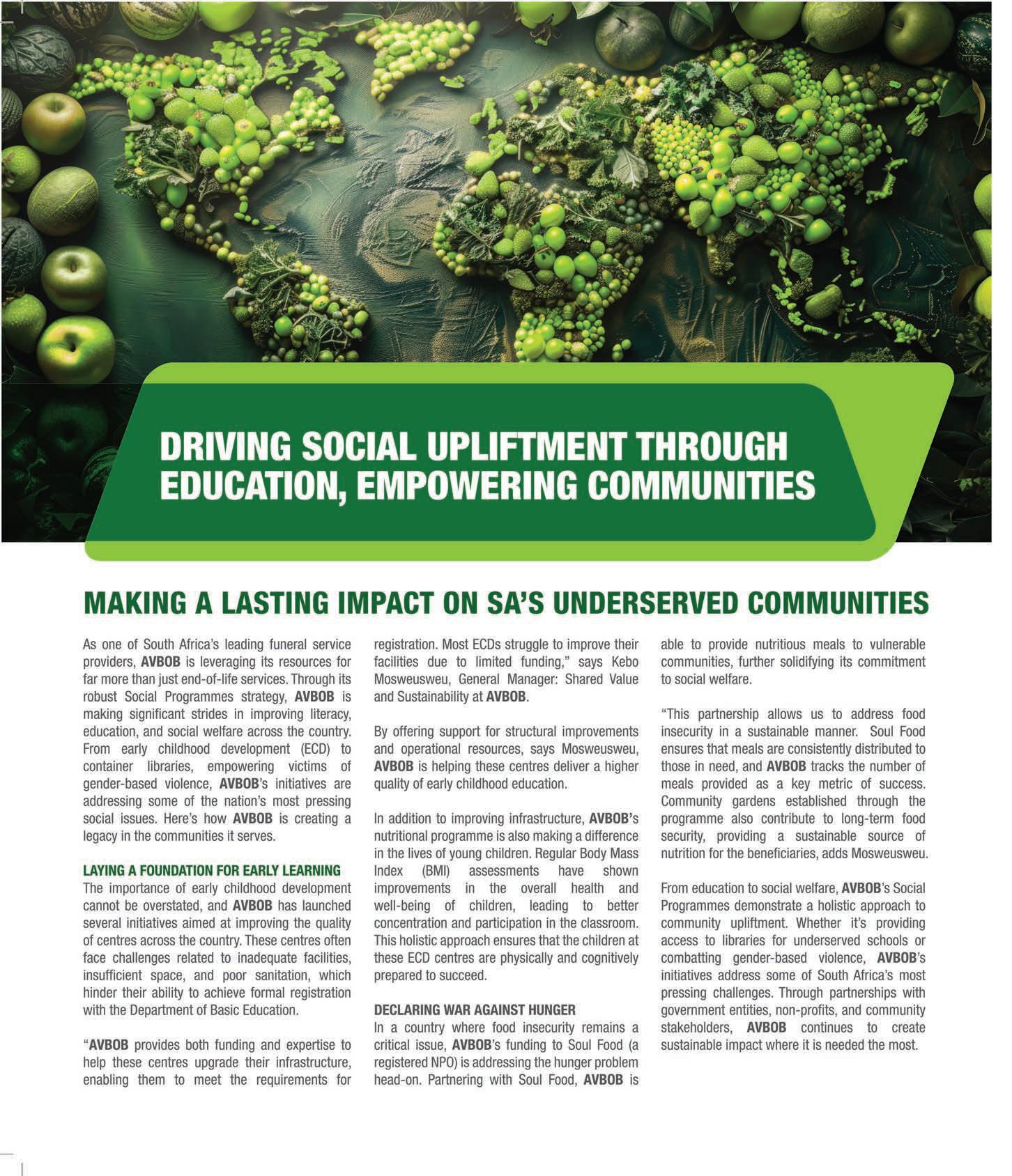

TECHNOLOGY provides professional qualifications and undertakes research focused on food safety and security and reducing food waste
The University of Johannesburg Department of Biotechnology and Food Technology offers quali cations in undergraduate (diploma and advanced diploma) and postgraduate (BSc Honours, MSc and PhD) studies in both biotechnology and food technology.
The department seeks to cultivate a research mindset among scholars that fosters solutions to environmental, industrial, agricultural, food and health-related challenges. As such, research in the department contributes towards food security by advancing ve of the United Nations (UN) Sustainable Development Goals (SDGs). SDG 4 emphasises quality, inclusive and impactful education in the biotechnology and food technology elds.
We also leverage partnerships (SGD 17) to ensure effective education and experience for our students. Research activities contribute towards food security and societal impact by advancing knowledge in food science and technology while addressing SDGs 2, 3, 12 and 13, respectively.
We advance SDGs 2 and 3 by developing nutrient-dense and health-promoting ready-to-eat and/or ready-to-process functional food products using locally available, indigenous and underutilised food sources. Such products have the potential to address the triple burden of malnutrition plaguing developing nations and lower the risks of some noncommunicable diseases and health challenges.
Regarding the latter, product safety is inextricably tied to food product development,

necessitating proper storage and packaging conditions along the supply chain. At our department, we contribute to food safety through the development of intelligent packaging systems using natural pH-responsive pigments that serve as quality and freshness indicators of packaged food.
In addition, various plant-based extracts are assayed to test their ef cacy as inhibitors of spoilage and pathogenic micro-organisms in food, thereby improving consumer con dence and experience. Such interventions prevent food spoilage through timely identi cation of food spoilage and growth inhibition of food spoilage micro-organisms, thus reducing food waste and improving food security.
Likewise, activities towards reducing and/ or eliminating the presence of mycotoxigenic fungi and associated mycotoxin production that could result in severe economic losses and negatively impact human health.
Considering the substantial food waste generated from farm to fork, our research efforts are also aimed at promoting circular economies, which underscores SDGs 12 and 13. This includes using food industrial byproducts, such as fruit pomaces, cereal brans and brewer’s spent grain, to create value-added products.
The processes underlying the development of these products include ultrasoundassisted and supercritical extractions of bioactive compounds, fermentation into edible food products and the development of biodegradable 3D-printed food packaging. Furthermore, phytochemicals derived from fruit and vegetable waste are used to develop nano-edible emulsions to confer protection
against reactive oxygen species as well as their formulation into cosmetic and pharmaceutical products where they function as colourants and antioxidants. The repurposing of these waste byproducts plays a signi cant role in the management of the global food waste crisis.
Finally, our research also contributes towards climate action by using a greenhouse-type solar drier to increase the shelf life of perishable agricultural produce. This has the double bene t of improved microbial safety and product quality of fresh produce when compared to conventional sun drying.
All these are accomplished with the support of our local and international partners and collaborators.

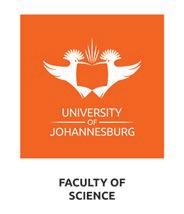
For more information: www.uj.ac.za/faculties/science web-science@uj.ac.za

SAKHILE DUBE asks if digital technologies and artificial intelligence can transform food systems globally
The global food system is grappling with the challenges of ensuring food security and nutrition for a rapidly increasing population, supporting the livelihoods of millions involved in the food supply chain and doing so sustainably.
The United Nations predicts that globally there will be nearly 10 billion people by 2050, with the majority living in Africa and Asia. To meet the food needs of this growing population, global food production must increase by 60 to 70 per cent, according to a 2023 report by Genesis Analytics.
Climate change poses a signi cant threat to global food security with extreme weather events making it even more dif cult to produce enough food for the growing population. For example, Southern Africa suffered the worst drought in over a century during the January to March 2024 agricultural season, particularly affecting countries such as Zambia, Zimbabwe and Malawi, which have been declared disaster areas by the World Food Programme.
Addressing these challenges requires innovative solutions to enhance productivity and resilience, critical for global food security and the economic development of developing nations.
The rapid advancement of digital technologies and arti cial intelligence is reshaping industries worldwide. In agriculture, these new tools are helping farmers use resources such as water and fertiliser more wisely. This helps protect the environment and make farming more sustainable.
Ntsako Gabaza Khosa, an arti cial intelligence (AI)-augmented human capital business partner at Old Mutual, highlights that in countries, such as the United States and India, AI-driven tools are being used to analyse soil health, predict weather patterns and manage crops more ef ciently. Similarly, in South Africa, the Western Cape Department of Agriculture is leading initiatives that use AI for real-time crop monitoring and optimised irrigation, particularly in high-value sectors such as wine and fruit production, she says.
In developing countries, digital innovations, such as mobile agriculture apps and AI-driven advisory services, are making signi cant strides in addressing food security and nutrition challenges. For example, in Kenya, the iCow app provides farmers with real-time advice on livestock management, while in South Africa, the Khula! app connects small-scale farmers
AI AND DIGITAL TECHNOLOGY ARE CHANGING FOOD SUPPLY CHAINS WORLDWIDE BY MAKING IT EASIER TO TRACK FOOD, REDUCING WASTE AND KEEPING FOOD SAFE.
with markets and suppliers, improving their access to vital resources.
AI and digital technology are changing food supply chains worldwide by making it easier to track food, reducing waste and keeping food safe. Companies, such as IBM’s Food Trust blockchain, lead the way in food traceability, helping stores track products from the farm to the table. South Africa is also making progress with start-ups, such as the Green Cape, using AI and blockchain to track agricultural products and ensure they meet food safety standards in South Africa and internationally.
Although global malnutrition rates have been declining, UNICEF reports that one in four children worldwide faces severe food poverty. In South Africa, AI plays a crucial role in reducing food waste. Organisations such as FoodForward SA use AI to distribute surplus food to communities in need, addressing both food waste and hunger.
Digital technologies and AI tools are not yet widely used, mostly in developing countries. Adopting these technologies can be dif cult, particularly for small-scale farmers.
Khosa points out that, globally, these farmers often struggle with limited access to technology and digital skills. In South Africa, small-scale farmers face similar challenges, along with high costs and infrastructure limitations.

Closing the gap in digital access remains a major challenge. Global organisations such as the International Telecommunication Union (ITU) stress the importance of expanding internet access in rural areas. Programmes such as the AgriTech programme in South Africa and Digital Green in India demonstrate how to ensure they have equitable access to these technologies, empowering small-scale farmers to use digital innovations for better livelihoods.
Khosa highlights that to address these digital divide challenges, there is a need to scale up initiatives, such as South Africa’s Comprehensive Agricultural Support Programme (CASP), and international efforts, such as the World Bank, to expand its support for AI in agriculture, particularly in developing countries. These programmes aim to make AI technologies more accessible and provide the necessary training to empower small-scale farmers globally and locally, she says.

ELRIZA THERON shares lessons from Discovery Vitality’s HealthyFood benefit
New research by Discovery Vitality highlights how unhealthy diets can signi cantly increase health risks, such as obesity, which contribute to the global disease burden, particularly in relation to noncommunicable diseases such as cardiovascular diseases, diabetes and cancer. Discovery Vitality’s core purpose is to make people healthier and enhance and protect their lives. Aligned with this objective is its HealthyFood bene t, which empowers healthier choices for over 400 000 families.
“At Vitality, our mission goes beyond simply promoting healthier lifestyles. It’s about fundamentally improving the way people approach their health. Our commitment to
“AT
this is rooted in the understanding that small, positive changes in daily habits can lead to incredible long-term health bene ts,” says Dinesh Govender, CEO of Discovery Vitality.
According to the report, almost half of the global population does not adhere to their national dietary guidelines, which are designed to promote health and prevent diet-related diseases.
It highlights that in 2017 the largest gaps in optimal intake were nuts and seeds (only 12 per cent of the optimal intake), milk (16 per cent) and whole grains (23 per cent), while the intake of unhealthy foods, such as
sugar-sweetened beverages, was 16 times higher than recommended.
The report also indicates that South Africans consume 43 per cent less fruit and vegetables than recommended, where the recommended intake is 400 grams or ve servings per day. It’s important to eat foods from all the food groups, including fruit and vegetables, whole grains, legumes, proteins, dairy and healthy fats, in quantities that are appropriate for you. These minimally processed foods are the cornerstone of a balanced diet.
Dr Mosima Mabunda, Discovery Vitality’s chief clinical of cer, notes that food purchasing trends show a worrying shift towards ultra-processed foods high in sugars, saturated fats and salt, with insuf cient purchases of fruits, vegetables and whole grains. She adds that in some countries, these now account for 50 to 60 per cent of daily energy intake, as cited by an article in The Lancet. “These purchasing behaviours have a direct impact on diet quality, leading to

inadequate consumption of essential nutrients and contributing to a range of health issues.”
In addition, South Africans consume 70 per cent more salt and 82 per cent more sugar than the recommended limits. The recommended daily salt consumption limit is 5 grams (just short of a teaspoon), whereas South Africans consume an average of 8.5 grams per day. Sugar, on the other hand, should not exceed 50 grams a day (about 12 teaspoons), however, South Africans consume on average a staggering 91 grams daily.
Prof Salome Kruger from North-West University says: “In South Africa, the prevalence of noncommunicable diseases, such as type 2 diabetes, hypertension and certain cancers, is closely linked to dietary habits. Healthy foods, such as lean meats, sh, eggs, vegetables, fruits, legumes, nuts and whole grains, provide essential nutrients such as protein, bre, minerals and vitamins. These minimally processed foods are the cornerstone of a balanced diet.”
The report also highlights that regularly purchasing healthy foods causes a 13 per cent reduction in the likelihood of becoming obese, a 55 per cent reduction in the likelihood of having high-risk blood glucose levels and a 14 per cent reduction in the risk of hospitalisation due to cardiometabolic diseases, such as heart disease and diabetes.
This is why nudging members to develop healthy eating habits by incentivising healthy food purchases is core to Vitality’s purpose, as a healthier society is more productive and puts less strain on the health system.
The HealthyFood bene t aims to increase access to healthier foods and to raise awareness of healthier options in each food category by clearly marking them with the Vitality indicator (V) in the HealthyFood bene t catalogue. In addition, food labels, such as the Vitality indicator, are used in partner stores and online to improve consumer understanding of food products’ nutritional quality by simplifying complex nutritional information. This makes it easier for consumers to make healthier food choices.
“Research shows that effective front-of-pack labels not only help consumers identify

healthier foods, but also encourage the food industry to reformulate products, reducing harmful nutrients such as saturated fats and sugars. This dual effect contributes to lowering obesity and diet-related noncommunicable diseases,” says Dr Mariaan Wicks, senior lecturer at the Centre of Excellence for Nutrition at North-West University. She adds: “By making nutritional information more accessible, front-of-pack labels have the potential to signi cantly reduce the burden of obesity and noncommunicable diseases in the country.”
Since its introduction to the Vitality programme in 2009, the HealthyFood bene t has evolved to be more convenient and rewarding, with Vitality members having purchased over 220 million HealthyFood items and earning over R1-billion in rewards over the past three years. Some of the top HealthyFood items purchased this year include 4.5 million bags of tomatoes, 2.2 million trays of eggs, 3.4 million packs of bananas, 2.1 million trays of chicken and 2.9 million bags of apples.
“By leveraging the latest research and insights, we’ve created an environment that not only motivates healthier behaviour, but also makes it easier for our members to stick
“IN SOUTH AFRICA, THE PREVALENCE OF NONCOMMUNICABLE DISEASES, SUCH AS TYPE 2 DIABETES, HYPERTENSION AND CERTAIN CANCERS, IS CLOSELY LINKED TO DIETARY HABITS.” – PROFESSOR SALOME KRUGER
with these changes over the long term. As we continue to expand our offerings, our focus remains on the health and wellbeing of our members,” adds Govender.
The report also highlights that government can safeguard public health through legislation, policies and education and that effective interventions make healthy foods more accessible, affordable and appealing while aiming to discourage the consumption of unhealthy options.






Smallholder farmers are often on the periphery of the food industry, yet farmers such as Fhatuwani Makahane prove they are at the forefront of the fight against food insecurity, writes MASEO FREDDY NETHANANI
Fhatuwani Makahane, born and bred in Ha-Makuya Musunda village outside Thohoyandou in Limpopo, is the owner of Dzialwa Farming and Projects (Dzialwa Genetics). Although his grandfather had more than 3 000 livestock, Makahane initially decided to pursue a different career. Like many children in the area, he attended Matshikiri Primary School and Makuya Secondary School, after which he took a gap year. He eventually furthered his studies at the University of South Africa and completed his degree in psychology.
However, ve years ago, he started to raise goats, sheep, cattle and pigs. Currently, Makahane has various types of goats, including Saanen Milk Goats from Gauteng, Indigenous Veld Goats, Speckled Goats, Lob-ear Goats and Red Kalahari Goats, totalling around 125, all from reputable breeders.
He says farmers need to diversify to create a balance because there are times when they have to supplement their animals’ nutrition
with leftover crops. “You grind them and add molasses and other ingredients to increase the nutrient content. Smart farmers always diversify so their practices are more cost-effective,” he explains.
Makahane recalls that this year was worse than the previous ones because of the drought, which caused feed prices to skyrocket. He adds that those with other forms of crops were able to survive the drought with minimal challenges.
Makahane started animal farming in 2017 and in 2019, he started crop production on a smaller scale. He subsequently increased his operations in 2022 because, for him, it was more bene cial in terms of food production for the community and his family. “I want to be seen as a hardworking farmer and to teach the upcoming generation that they can start earning their own money early in life instead of
having a mentality of entitlement or waiting for the government to do something for them. I plan to go bigger and make farming a serious career,” he says.
“Farming helped me to create another source of income, and in this way, it also helps me to deal with the stresses that can come from a busy lifestyle,” he continues.
“As a psychologist, I face people daily who are going through serious challenges, so when I go see my animals, I clear my head.” To him, animals can communicate in a unique kind of language, and any person who sees him with his animals will understand what he means. “So, I do not pass a day without seeing them,” he says.

Makahane prefers self-suf cient animals, and problematic livestock are usually used to provide for his family. “I have learned my
“FARMERS SHOULD BE SUPPORTED IN ANY WAY POSSIBLE SO THAT THEY CAN CONTINUE TO PROVIDE HEALTHY FOOD TO THE NATION. A NATION THAT TAKES FARMING FOR GRANTED IS DOOMED.” – FHATUWANI MAKAHANE

“WE HAVE LEGENDS WHO ADVISE US, USING INDIGENOUS KNOWLEDGE ABOUT DISEASE CONTROL.” – FHATUWANI MAKAHANE
lesson that sometimes, despite the price I bought them for, they succumb to diseases such as heartwater. We also have a stock theft problem. I have livestock in Gauteng, where I primarily have Damara Sheep and Red Kalahari Goats, which are raised in the veld and supplemented when needed, but I try to make my animals as dependent on the veld as possible,” he says.
He learned from farming that one needs to complement nature and not farm against it, as that is where you’re likely to encounter losses. He recommends looking for animals that can adapt easily to the area where a person farms.
“I am a member of several professional auctions that sell livestock ranging from as little as R10 000 for a goat to a staggering R200 000. I see myself as a breeder rather than a commercial farmer as my intention is to become a stud breeder,” comments Makahane.
In terms of employment, Dzialwa Farming and Projects (Dzialwa Genetics) has created ve permanent employment opportunities, overseeing different aspects of the farming
operation, from crops to animals and poultry. “The government cannot help us all, and I can’t blame the government as their programmes may not have reached me. Perhaps later, my business can become more visible and people can see what I am doing because my farming is not only farming; it is a way of life, and many people bene t from it. For instance, at the moment I am mentoring and helping people in a village near my farm by supplying them with free water for their crops. Because I use a solar borehole, I can share what I have with others who are struggling,” he says.
He emphasises that without food, people cannot live, so farming is not just a job; it is a career and a lifestyle.
“Farmers should be supported in any way possible so that they can continue to provide healthy food to the nation. A nation that takes farming for granted is doomed because they will need to depend on other nations, which could come at a hefty price.”
Makahane says that he learned a lot from a group called Vhembe Emerging Farmers

about a variety of topics covering anything to do with farming, from crops to livestock. “This group is knowledgeable, and we have legends who advise us, using indigenous knowledge about disease control. The other group is Mutingati, where money talks, as farmers pool money together for the whole year in preparation for the dry season, buying feed in bulk for their livestock and sharing this to reduce the possible risk to their animals,” he says.
Another way the communities around his operations bene t is by him allowing them breeding access to his livestock with quality genetics. This way, they can improve their own livestock and sell them at a higher premium. In addition, it gives them the opportunity to learn from each other and assist with the process of resales as they often face the challenge of market access due to a lack of resources.
Makahane has many future plans to assist and grow his community through his farming operations, including a seed bank to distribute seeds to the community, free of charge.
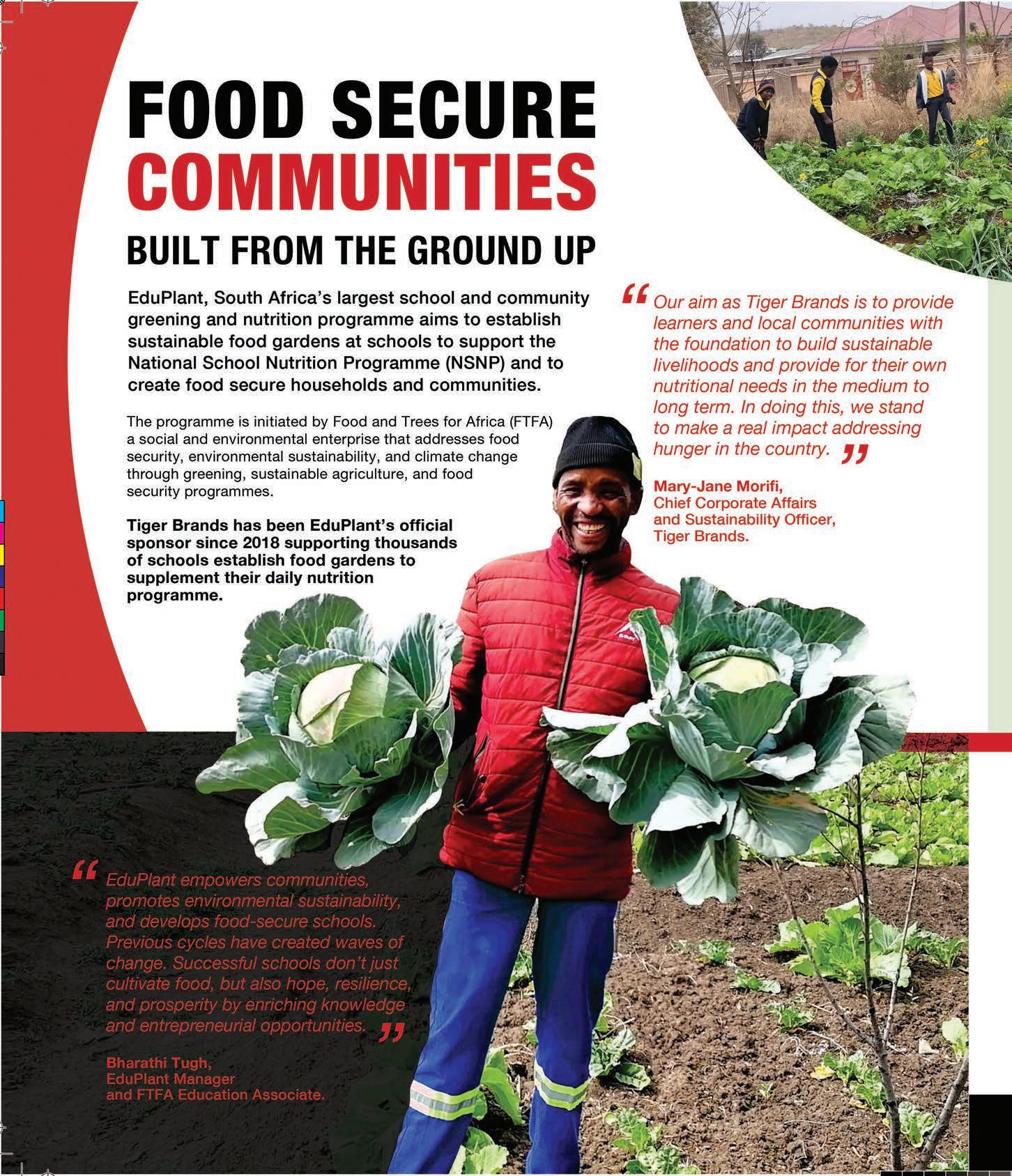

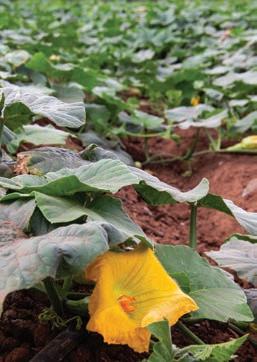
The experts agree that South Africa’s food system remains deeply rooted in the inequalities of the past as nutritional insecurity persists despite the availability of sufficient food in the country.
By COLLEEN DARDAGAN
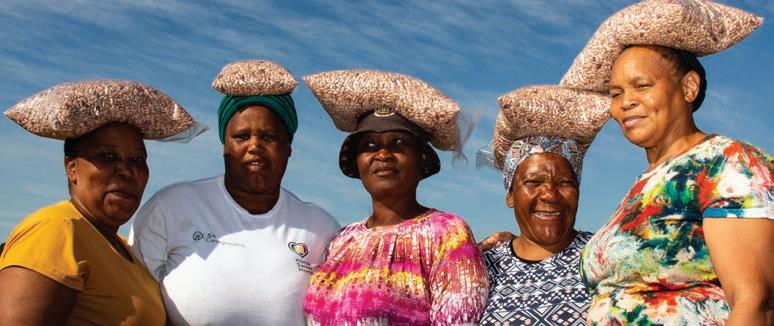
Increased poverty on one hand and an obesity epidemic on the other, coupled with at least 33 per cent of all food produced in South Africa going to waste, are clear signs that the country’s food system needs improvement. On the back of this, certain concepts are crucial when considering the important role food plays in our daily lives. One of these is food security. The term was rst coined in 1996 at a World Food Summit in Rome, and de ned as “when all people, at all times, have physical, social and economic access to suf cient, safe and nutritious food that meets their dietary needs and food preferences for an active and healthy life”.
At the same summit, the concept of food sovereignty was launched by La Via Campesina – an international farming organisation founded in 1993 in Belgium –as the “right of each nation to maintain and develop its own capacity to produce foods crucial to national and community food security, respecting cultural diversity and diversity of production methods”.
In a recent United States Department of Agriculture: Foreign Agricultural Service report on retail foods in South Africa, just ve large companies are listed as accounting for 80 per cent of all retail sales. The remaining 20 per cent comes from informal markets,
the report says. The WWF Nedbank Green Trust Agri-foods Systems report contends by 2050 a South African population of as many as 73 million people will double the demand for most commodities with meat and milk demand expected to rise by more than 200 per cent in the country.
Further, future food security is not only about increasing production; it must be determined and guided by the “interconnected delivery priorities of the Sustainable Development Goals”.
“Trends in nutrition shifts, poverty, ecological impacts and climate change all demand a decidedly different approach,” the report says.
It focuses on ve practical areas for transformative change in the country’s food system:
• inclusive regenerative farming;
• optimal water use;
• responsible sourcing;
• reducing food waste; and
• dietary shift.
Similarly, in a paper published in the July 2024 South African Journal of Science titled “South Africa’s food system: An industry perspective
•8.5 million South Africans directly or indirectly depend on agriculture for income.
•R27-billion in losses to South Africa’s gross domestic product from 2006 to 2015 due to diabetes, stroke and coronary heart disease. By 2030, according to economics-based consulting firm, Genesis, this spend will reach R19.2-billion a year.
• By next year 50 per cent of all South Africans will live in urban areas.
•70 per cent of food waste and loss is fruit, vegetables and cereals.
Source: WWF Nedbank Green Trust Agri-foods Systems report, adapted from SA Food Lab, 2015 .
on past, present and future application of science and technology”, authored by Dr Lisa-Claire Ronquest-Ross and Professor Gunnar Sigge, South Africa’s food system was described as “facing severe challenges”. Shifts in local food consumption since 1994, the research says, are concerning due to the nutritional composition of the food consumed and its impact on public health.
In a paper published by the same authors in 2015, “Food Consumption Changes in South Africa since 1994”, food patterns were described as having changed dramatically towards a more “Western-oriented diet”, evidenced by the rise in obesity in the country and the fact that price was the key decision-making factor when buying food.
“A healthier diet can cost as much as 69 per cent more than a typical South African diet, which means such a diet is largely unaffordable for most,” the study stated. Further, exponential growth in urbanisation is changing eating habits at a pace. In a revised report, the Food and Agriculture Organization of the United Nations, suggests urbanisation will not only transform domestic agrisystems, but change the quantity and quality of food demand and supply.
These kinds of shifts in food systems are worth noting as it will inevitably inform our decision-making in working towards more sustainable food production.
BY 2050 A South African population OF AS MANY AS 73 MILLION PEOPLE WILL DOUBLE THE DEMAND FOR MOST COMMODITIES WITH MEAT AND MILK DEMAND EXPECTED TO RISE BY MORE THAN 200 PER CENT IN THE COUNTRY.
Healthy soil is a key driver of farm productivity, profits and sustainable food production, writes MAGDA DU TOIT
It is estimated that 95 per cent of food production is in some way reliant on soil. Yet soil is a resource that has been taken for granted and even neglected for many years. It is, however, possible to reverse soil degradation by changing agricultural practices to rebuild the soil, says Dr Hendrik Smith, a conservation agriculture facilitator at ASSET Research.
He says soil biology has a direct effect on soil structure and chemistry and is key to soil health. “Healthy soils can store vast amounts of carbon and water, which helps slow down global warming. The movement of carbon from the atmosphere to the soil is a powerful tool at our disposal to restore our soil and reduce atmospheric carbon dioxide.”
Tyson Zunckel, a farmer from the Bergville area in KwaZulu-Natal, agrees that improving soil health creates healthier plants that can take more carbon from the atmosphere into the soil via photosynthesis.
Dr Smith notes that soil degradation can be reversed by limiting tillage and optimising other regenerative agricultural principles. He recommends farmers rotate crops, plant cover crops, retain crop residues on the soil surface and integrate livestock. “Diverse cover crops and livestock could be rotated within traditional cash crop rotations.”
One of the key elements in conservation tillage and regenerative agriculture is to reduce soil disturbance, says Zunckel. “At Zunckel Farms we leave post-harvest crop residue to cover the soil surface and planting occurs directly into the stubble.”
Dr Smith points out that the roots of cover crops create channels in the soil that improve water retention. “Cover crops also

build soil organic matter, hold soil in place and feed soil organisms that provide valuable nutrients to cash crops during the traditional growing season.”
Balfour farmer Danie Bester says each cover crop is a solution to a speci c problem. “It is crucial to know what the soil issue is and which solution to turn to.” Crop diversity also increases the above-ground biodiversity, such as bene cial insects, while live root systems reduce soil erosion as they keep the soil intact and provide food for organisms such as earthworms and microbes that recycle nutrients. Dr Smith points out that cover crops also allow for the sustainable and pro table integration of livestock.
Bester says 80 per cent of his yields are determined by soil condition. “Productivity is inherent in the soil. The availability and
“HEALTHY SOILS CAN STORE VAST AMOUNTS OF CARBON AND WATER, WHICH HELPS TO SLOW DOWN GLOBAL WARMING.” – DR HENDRIK SMITH
uptake of plant nutrients, soil practices and moisture are the factors that determine your yield and pro tability. Healthy soil biology will unlock the potential in your soil as it is only through biological actions that the nutrients become available to plants in a usable form. The other 20 per cent of my yield is dependent on cultivar choice, my implements and planter precision.”
He says soil management is not a single system and should be incorporated into, or part of, the total picture. He follows no-till practices, which are key in regenerative agriculture to optimise soil moisture retention, reduce compaction and enhance the microbes in the soil. Bester cautions, however, that soil health management is not a quick remedy or a once-off x.
Zunckel agrees: “Our soil management practices are paying off – we can see the difference in the soil. The soils are darker and softer and contain more organic matter. Soil samples show that we increased the carbon in the soil over the past 12 years. Apart from that, we also saw an increase in general animal life on the farm. Although we increased our pro tability, we focused more on what was right for the soil, imitating nature. As time went by, we have also reaped the pro tability rewards.”

Earthworms play an important role in soil health and the restoration of soils as they redistribute organic matter and play a role in stabilising aggregates. Their presence can contribute significantly to improved soil structure.
As the world grapples with the challenges of food scarcity, agriculture is emerging as a cornerstone for ensuring global food security and the survival of families worldwide. With populations growing and arable land diminishing, the need for sustainable and ef cient farming practices has never been more urgent.
Omnia Agriculture is at the forefront of this movement, driving innovation and championing practices that not only boost crop yields, but also prioritise the health of soils and ecosystems.
Under the leadership of James Freemantle, Omnia Agriculture’s focus on sustainability and nutrient-use ef ciency is helping to shape the future of agriculture in key markets such as Australia, Brazil and the United States (US).
Re ecting on some of the industry’s growing trends globally, Freemantle says: “Our focus on sustainable solutions is not just a trend; it’s a core business strategy that aligns with global shifts towards more responsible farming practices.”
As a result, sustainability has evolved from a mere buzzword to an essential pillar of modern agriculture.
“We’re seeing a big push for crop nutrition and soil health products with a strong sustainable narrative. This is more evident in Australia, Brazil and the US – markets critical for Omnia Agriculture’s growth strategy,” Freemantle adds.
In these regions, he says, farmers and agricultural businesses are increasingly looking for ways to improve soil health and boost crop yields while minimising environmental impact. This shift towards sustainability is driving demand for products that enhance soil fertility, reduce reliance on chemical fertilisers and promote ef cient nutrient use.
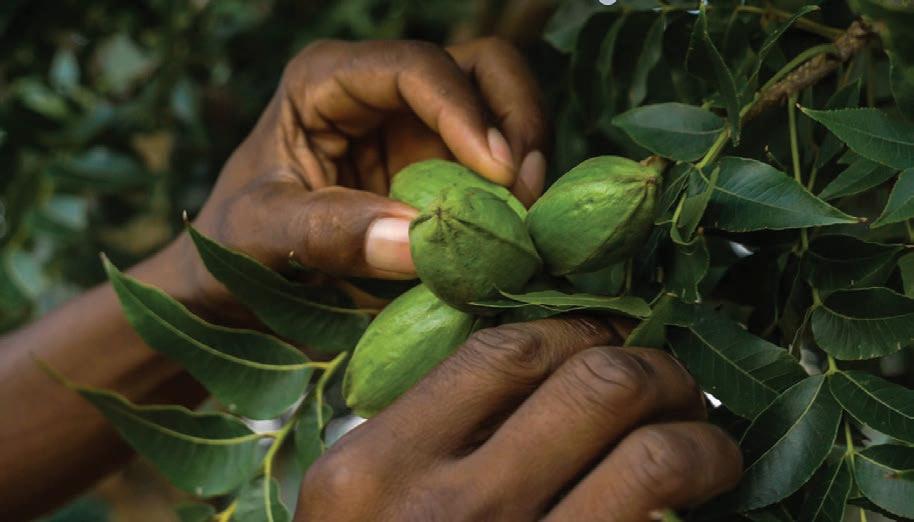
Freemantle notes that soil health is a critical component of sustainable agriculture, with Omnia Agriculture at the cutting edge of this innovation.
“A big area we’re focusing on is soil health and building soil health and fertility. Our products are designed to provide balanced nutrition, ensuring that crops receive the right nutrients in the most ef cient way possible.
“These products really focus on mixing traditional fertilisers and advanced chemical nutrition, making them a little bit greener and softer and more ef cient,” says Freemantle.
By blending traditional methods with modern innovations, Omnia Agriculture is helping farmers optimise their yields while reducing environmental impact.
Because technology plays a pivotal role in the future of agriculture, Omnia Agriculture is leveraging advanced technologies to enhance nutrient use ef ciency and improve overall crop performance.
“It really centres around the technology. By harnessing the power of technology, we can offer solutions that are not only effective, but also environmentally friendly,” says Freemantle. These technological advancements are particularly crucial in markets like Brazil and the US, where large-scale farming operations require innovative solutions to meet the growing demand for food. In Australia, where the climate can be challenging, Omnia’s technology-driven approach is helping farmers adapt to changing conditions and maintain productivity.
He is optimistic about the future, emphasising the importance of staying ahead of the curve.
“If you want to grow better, stronger, longer-yielding crops, not just for this year but into the future, you need to make sure that their prime or crop is getting the right nutrients,” he elaborates.
Globally, says Freemantle, the agricultural community is more aware than ever of the need for sustainable practices, adding that: “Omnia Agriculture’s commitment to innovation and sustainability is set to play a crucial role in meeting this demand, ensuring that farmers worldwide have access to the best products and technologies available.
“The future of agriculture lies in our ability to innovate and adapt to the market’s changing needs,” he concludes.
With the company’s commitment to sustainability and cutting-edge technology, Omnia Agriculture is well on its way to leading the global agricultural industry into a more sustainable and ef cient future.



Genome editing in agriculture enhances climate resilience, combats food insecurity and promotes nutritional diversity through innovative crop development, writes CHANTEL ARENDSE , lead for plant biotechnology at CropLife South Africa
Food is an undeniable basic human right. Yet hunger persists and these hunger challenges are further aggravated by the susceptibility of our global food systems to external shocks, such as global con icts, recurring climate catastrophes and economic downturns, not only causing food prices to spike, but also disrupting access to our food supply.
The United Nations says the risk from climate change is a major contributor to food insecurity – increasing temperatures, frequent ooding and extreme weather events are making it harder for farmers to grow as much food as they did previously. Ironically, many technologies that boosted our agricultural productivity in the 20th century and helped reduce global hunger are now contributing to the problem. Certain chemical fertilisers, for example, emit greenhouse gases into the atmosphere as do fossil fuels used to power farm equipment.
Tackling these pressing challenges creates a sense of urgency for agricultural production to keep up with the demands of producing more nutritious food while using fewer resources and with less impact on the

environment. Fortunately, our food systems can take advantage of decades of innovation in the agricultural sector to deliver a range of climate-smart technologies to meet the ambitious goals of feeding the world sustainably while mitigating climate change.
Over the past decade, innovations in plant breeding have given rise to a new group of tools broadly known as genome editing. The science of genome editing is grounded in the principles of traditional plant breeding, allowing scientists and breeders to make small precise changes within the plant’s DNA to achieve new varieties with desired characteristics in a matter of years instead of decades.
The technology is being deployed in research laboratories across the globe, offering solutions to mitigate the biggest threats facing modern agriculture. These include applications in important cereal crops to improve their ability to withstand excessive heat, droughts and ooding as well as threats from important pests and
OUR FOOD SYSTEMS CAN TAKE ADVANTAGE OF DECADES OF INNOVATION IN THE AGRICULTURAL SECTOR TO DELIVER A RANGE OF CLIMATE-SMART TECHNOLOGIES.
diseases. Developing these climate-resilient crops will help our farmers adapt and mitigate changing climates while maintaining productivity at levels that support global food demands.
Responding to the food security challenge is not just about maximising agricultural production volumes; nutritional security is equally important, considering the major health challenges we face as a society.

On this front, genome editing technologies are facilitating bioforti cation efforts in fruits, vegetables and cereals enriched with vitamins and minerals to address nutrient de ciencies and related diseases in developing country populations where this is a major problem. For most of the world’s population, the daily calorie intake is limited to food staples such as rice, wheat and maize. The versatility of gene editing tools is also being utilised to improve the productivity and nutrition of indigenous crops, such as cassava, sorghum, millet, yams, and many more, providing opportunities to diversify and readily integrate indigenous food crops into
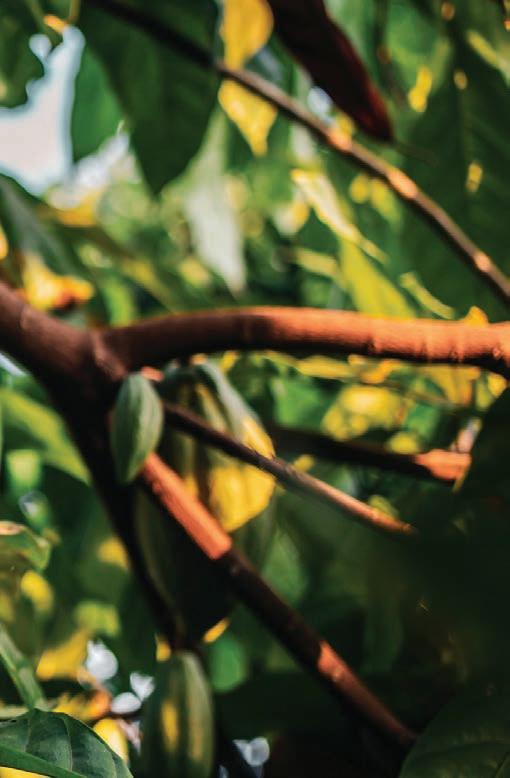
mainstream diets, especially in Africa, where alternative and more nutritious food options are sorely needed.
Despite the relative infancy of gene editing technology, its widespread application and use in a diversity of food crops demonstrate its potential to make a signi cant contribution to addressing the food security challenge. These types of innovative solutions are also needed in Sub-Saharan Africa where the food security situation is much more dire and the
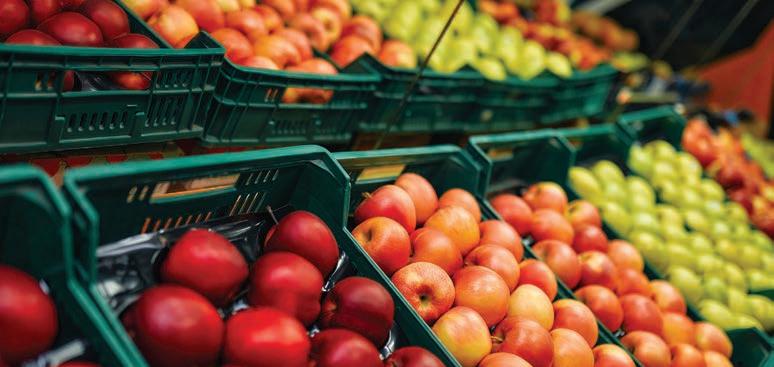
impact of climate change is being felt, with more severe risks looming. Recent droughts in the Southern African region, triggered by an El Niño weather event, have caused serious crop failures and food shortages, further justifying the need for investment in climate-resilient technologies.
Realising the potential of gene editing technologies requires that regulatory environments enable the uptake and bene ts of these innovative tools to deliver better food products. As more countries re ne their regulatory pathways, there’s emerging consensus that such regulatory oversight must be science-based and consider the divergent product’s outcomes on a case-by-case basis.
In countries that have adopted this pragmatic, innovation-friendly approach, there is a greater interest to invest in the technology and its use in delivering tailored solutions to bene t and address local disease and climate priorities.
In Africa, where production levels continue to lag and food insecurity remains rife, there’s been a small, but positive, regulatory
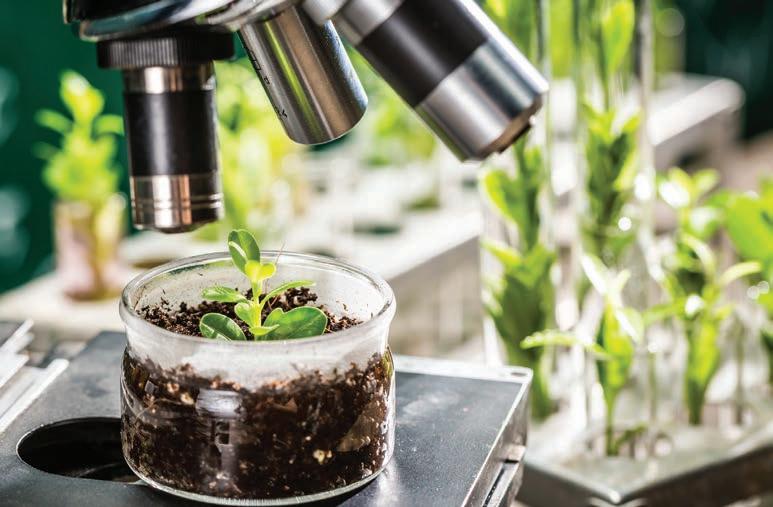
Biofortification is the process by which the nutrient density of food crops is increased through conventional plant breeding and/or improved agronomic practices and/or modern biotechnology without sacrificing any characteristic preferred by consumers or, most importantly, farmers.
Source: World Health Organization
shift towards embracing new technologies for crop improvement, particularly in Kenya and Nigeria. In this regard, South Africa is a notable exception, opting for more restrictive and onerous regulations for gene editing, thereby deterring research and investment for its integration into local plant breeding programmes.
With the world’s population projected to exceed nine billion by 2050, our farmers will need to produce up to 70 per cent more food to meet global food demands. With the hard-hitting reality of climate change already impacting us, it will be more challenging for farmers to produce more while using less resources.
Changing the trajectory of our agrifood system to meet these food security targets successfully demands that we embrace innovative technologies as part of the solution. With its potential to help alleviate food insecurity and provide healthier food options, genome editing as a crop improvement tool complements the global call to action to accomplish zero hunger and mitigate the climate crisis.


Global agriculture company CORTEVA AGRISCIENCE is committed to ensuring farmers have access to education and technological innovations to improve their crop yields, resulting in greater food security and economic growth

In the rapidly evolving landscape of global agriculture, food security is a paramount concern. With the world’s population projected to reach nearly 10 billion by 2050, according to United Nations estimates, ensuring everyone has access to suf cient, safe and nutritious food has never been more critical.
From climate change to economic uncertainty, food security has emerged as a fundamental pillar of economic stability and growth. At the heart of this challenge are smallholder farmers, whose contributions are vital to both local food systems and broader economic resilience.
Ensuring every individual has reliable access to nutritious food is not just a matter of health; it’s a catalyst for building resilient communities, empowering farmers and tackling food waste.
Corteva Agriscience, an agricultural technology company, is at the forefront of addressing this challenge. Through its innovative technology, sustainable practices and strategic partnerships,
is not only enhancing food security, but also fostering economic growth for farmers and rural communities worldwide.
Technology is transforming agriculture and Corteva is dedicated to ensuring smallholder farmers are not left behind in this revolution. The company’s approach integrates cutting-edge research and development with practical applications to enhance crop productivity and resilience. Corteva’s portfolio includes advanced seed varieties, crop protection products and biological solutions to help farmers optimise their yields and manage their resources more effectively.
Key to unlocking technology also requires investment in training and capacity building, which Corteva embraces through numerous activities, ranging from the annual intern programme and GIBS SoilSista Women in Agriculture programme to various eld agronomy days.

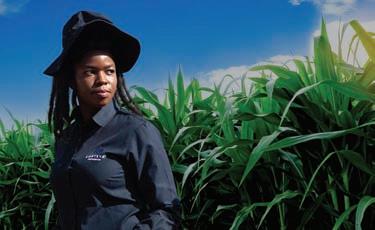
The company’s commitment to supporting smallholder farmers is grounded in the recognition that a secure and productive food system is essential for a resilient economy. By empowering farmers, Corteva not only addresses immediate nutritional needs, but also contributes to long-term economic stability.
“When farmers can produce more ef ciently and sustainably, the local economy is strengthened through increased productivity, higher incomes and job creation. This, in turn, enhances economic resilience and fosters broader social and economic bene ts,” says Nick Goble, Corteva SA Seed Business Lead.
As global agricultural demands continue to grow, Corteva’s role in enabling farmers and building stronger economies will remain pivotal. Through ongoing innovation and collaboration, Corteva is helping to shape a future where food security is assured, and agricultural communities thrive.


www.corteva.com
Nothing beats potatoes for best resource use and food security, writes LINDI BOTHA

When it comes to food security for low-income households, getting the most bang for your buck – the highest calorie return for money spent – is a prime consideration. For the environmentally conscious, the best calorie return for water spent is a leading consideration. Potatoes tick both these boxes: it is the staple with the lowest water footprint, coming in at a required 34 litres to produce a serving of 113 grams, according to The Water Footprint Calculator. A serving of maize meal requires 144 litres, a serving of rice 276 litres and two slices of bread 182 litres.
Potatoes are more nutrient-dense than any other staple in South Africa and contain high levels of potassium that are vital for proper nutrient uptake.
Potatoes have experienced a particularly tumultuous few years as drought, oods and load shedding have highlighted how quickly the stable supply of affordable potatoes can be unhinged. As blackouts took hold of the country last year, farmers reduced potato plantings over uncertainty that they would have the electricity to irrigate their crops. Production was reduced by 3 per cent, but prices shot up by 173 per cent, according to Potatoes SA.
In the Sandveld area of the Western Cape, farmers experienced a ve-year drought ending in 2022, followed by ooding this year. As climate change is acutely felt in the

Sandveld, the area is proving to be a prime example of what farmers nationally can expect in years to come. How this region manages water and production methods could become the example farmers elsewhere wish to either avoid or mimic.
Willie Jacobs, CEO of Potatoes SA, says water supply amid unpredictable weather needs to be stabilised to ensure potato production is not interrupted. “This will require better water monitoring systems to account for seasonal changes in underground water that can then be used to determine extraction amounts.
“We should also be looking at building more reservoirs to catch water in the wet season rather than have fresh water run into the sea. Strategically placed reservoirs could mean farmers will have enough water in the dry season to irrigate crops, rather than reduce production due to a lack of water.
With climate change bringing increased volatility in rainfall, this is the only way to ensure South Africa preserves our resources while ensuring food security.”
Farmers have made much progress in water-use ef ciency. Johan Smit, a potato farmer in the Sandveld, notes that water use has reduced by around 30 per cent over the past 20 years through advancements in water management technology. “We are doing everything we can to make the best use of every drop of water. We use soil moisture probes, take evapotranspiration gures into account from the weather stations around the farm, add the crop factor and get to a precise amount of water the potatoes need without wasting anything.”
With sensitivity around water, Smit is careful to limit borehole water extraction. “There are meters on every borehole, so we never extract beyond a certain level. It is important that a base level of water is maintained underground.”
Smit follows regenerative agricultural practices, which are taking hold among farmers in the area. Since potatoes can only be planted in a eld once every three years to prevent disease build-up in the soil, land was previously left fallow. But with environmental health in mind, farmers now plant a cover crop, such as rye, directly after potatoes have been harvested. The residual moisture in the soil and rye’s strong root system mean they don’t require additional irrigation. The rye not only keeps the soil covered, thereby preventing erosion, but also suppresses weeds, reducing the need for herbicides. When it’s time to plant potatoes again, the rye is cut and worked into the soil, boosting its organic content and further improving water retention.
While public concerns remain over agriculture’s water footprint, especially during a drought, potatoes have proven their worth. “We have tried other crops to nd the best way to utilise land and resources for food production,” says Smit, “but nothing beats potatoes for minimal water use, maximum food security and overall sustainability of the area.”
“NOTHING BEATS POTATOES FOR MINIMAL WATER USE, MAXIMUM FOOD SECURITY AND OVERALL SUSTAINABILITY OF THE AREA.” – JOHAN SMIT
DRY BEAN PRODUCERS’ ORGANISATION shares some insight into the role of dry beans in sustainable agriculture and food security in South Africa
South Africa has been producing dry beans for decades. The crop is often a small branch of farming, with a few exceptions in the Eastern Free State. This article examines the value dry beans add to sustainable agriculture and food security in South Africa.
Dry beans (Phaseolus vulgaris L.) are one of the most important legumes in the human diet. They can be eaten as is without further processing. Dry beans’ high protein content and the combination of carbohydrates, bre and minerals (especially iron and zinc) have been widely researched and widely known. However, the role of dry beans in a well-planned production system (rotation) is often overlooked.
Dry beans release fewer harmful greenhouse gases because people can consume them without any energy-intensive processing processes. In addition, dry beans remain stable when stored for later use.
Dry bean production has increased by almost 60 per cent worldwide since 1990 due to expansion in the sector, improved cultivars through breeding, better cultivation practices, quality seed management, improved soil fertility and harvest ef ciency.
The Andes and Central America are the two main centres of origin of dry beans. These centres are the basis of the material grown in more than 10 market classes and in different parts of the world.
The rich biodiversity of dry beans makes it possible to combine desired traits in cultivars across a wide range of geographical areas, growth types and grain types. This diversity creates the potential to make rapid progress in breeding. However, worldwide breeding progress has been slightly slower than expected, probably due to other factors, such as disease, climate differences, seed size, shape and colour.

Dry beans are an excellent rotation crop with speci c characteristics that make them better than other crops:
• Short growing season. Depending on the type of dry bean and the cultivar, the growing season varies from 95 to 145 days from planting to harvesting. By choosing the right type and cultivar, the producer can take advantage of speci c production windows where few other crops can t.
• Shallow root system. Dry beans generally have a shallow root system (up to 350mm deep). This makes it ideally suited as a rotation crop because it conserves water deeper in the pro le for subsequent crops. With crop rotation, it is important to plant at least three other crops on the land before planting dry beans again.
A de nition of nutrition and food security is “... the ability of a food system to provide suf cient energy and essential nutrients so the population can enjoy good health without compromising the ability of future generations to meet their nutritional needs”.
The impact of climate change, energy resources and resource distribution in the agricultural sector is changing rapidly. The challenges presented by this change require scienti c and technological input to ensure future food security. Legumes, which include dry beans, have little impact on the environment.
Dried beans are widely known for their exceptional nutritional value. The composition of the nutrients in dry beans distinguishes this crop’s nutritional value from other grains and legumes.
Continued education is essential to promote the value of dry beans as a healthy food that does not harm the environment. For sustainable food production, more plant-based proteins must be included in diets. Dry beans are a valuable food source and an excellent rotation crop.
The information in this article comes from, “Dry beans (Phaseolus vulgaris L.) as a vital component of sustainable agriculture and food security – A review”, authored by Mark A Uebersax, Karen A Cichy, Francisco E Gomez, Timothy G Porch, Jim Heitholt, Juan M Osorno, Kelvin Kamfwa, Sieglinde. Snapp and Scott Bales. It was published in Legume Science, 30 May 2022

Contatc Details: 012 819 8100 chris@beans.co.za www.droebone.com

Vorster continues by describing why they installed drip irrigation systems in their orchards in Ohrigstad and George.

Optimal use of natural resources, such as water, in agriculture is essential to maintain and protect the environment, writes MAGDA DU TOIT
In a water-scarce country such as South Africa, it is imperative to make every drop count. Michael Esmeraldo, managing director of Neta m South Africa, says the country’s farmers have come a long way in agricultural water-use ef ciency over the past couple of years.
When looking at modern agricultural technologies and practices in the context of resource pressure and increased food demand, modern farming is not only about using the latest technology, but also about farming more ef ciently, Esmeraldo says. “Many technologies are available to help farmers achieve greater ef ciency, and these are supported by substantial research.”
However, Esmeraldo points out that new tools and technologies cannot be optimally applied on the farm without the necessary supporting expertise. “As important as it is to develop new and ef cient tools, it is equally important to apply the technology and knowledge properly.”

Tielman Odendaal, irrigation specialist at Obaro, agrees: “The management of an irrigation system is crucial in water-use ef ciency. Apart from having access to optimal and ef cient irrigation systems, farmers and farmworkers should also be taught how to manage systems properly. One can have the best system, but if
it is not used optimally, water can be wasted. On the other hand, a farmer who manages an older or less ef cient system properly can still effectively use water and limit wastage.”
Eddie Vorster, Mahela group director, says to maintain and protect the environment it is important to understand how to optimally utilise natural resources. “Our water sources are important assets, but need meticulous management. We need to understand how to limit the impact of farming activities on water, soil and natural vegetation and adapt our irrigation practices to suit the soil type and climate by delivering precise quantities of water and nutrients to the roots of each plant.”
Vorster points out that although monitoring water usage is important, understanding water ow is equally important. “Precision irrigation allows us to save water and fertiliser by providing consistent and uniform water during critical growth periods, thus minimising water stress throughout the fruit development phase. Controlled release irrigation systems deliver water and nutrients directly to the root zone of the plant, which reduces overirrigation situations while addressing soil quality and erosion problems.”
“The Ohrigstad orchards are under netting, making it suitable for drip irrigation. The netting creates a micro-climate that reduces the effect of wind and lowers the soil temperatures. In George, the drip irrigation ensures the water reaches the critical zone around the plant roots. If we had installed micro-irrigation, the wind would have blown the water spray away from the ridges and root zones. Drip irrigation mitigates the effect of the wind on irrigation,” he explains.
In the Letsitele, Hoedspruit and Weipe areas, micro-irrigation is more effective as the wind does not pose the same challenges. “Soil temperatures can easily exceed 30 degrees Celsius during summer, and the micro-irrigation plays an important role in helping to cool down the soil temperature in the root zone area.” Vorster further explains that irrigation schedules are based on hourly readings from on-farm Irricheck moisture probes using continuous loggers. The physiological stage of the tree, together with the transpiration that occurs on a speci c day, are also taken into account. Flow meters alert the farm managers to any irrigation problems.

“By using the latest technologies, we have managed to use fteen to twenty per cent less water and only irrigate on average about three hours per day. I believe the industry knows that change is necessary, but we cannot focus only on on-farm practices, technologies and processing. It is important that policies and regulations are updated to be in line with modern farming and the demands of climate change and dwindling resources,” Esmeraldo stresses.
He points out that if farmers are encouraged to use water more ef ciently, but water allocations are still based on age-old statistics and water availability levels, only half of the problem will be addressed.
“BY USING THE LATEST TECHNOLOGIES, WE HAVE MANAGED TO USE FIFTEEN TO TWENTY PER CENT LESS WATER AND ONLY IRRIGATE ON AVERAGE ABOUT THREE HOURS PER DAY.” – MICHAEL ESMERALDO
Why establishing a home vegetable garden is an affordable and dependable source of a healthy food supply. By
KIMBERLY MUTANDIRO

Cultivating a home vegetable garden may not have been everyone’s favourite topic in South Africa, especially during the pre-pandemic era. For some, the thought came with a lot of frustration, such as spending a fair amount of time, effort and attention and having the right space. Even despite having lots of space, establishing a home garden would be a question of commitment and sustainability.
However, in recent years, growing our own vegetables and herbs has become an affordable and dependable source of a healthy food supply. Given climate change challenges, having a home garden that is sustainable and water-ef cient is essential. Growing our own food helps reduce our carbon footprint, saves precious water, decreases soil erosion, and fosters biodiversity. Gardening is climate-effective because it reduces ambient heat and increases oxygenation.
Experts say gardening is all about growing plants for carbon capture and fostering a balanced ecosystem that bene ts both humans
and the planet. Just like general agriculture, it’s about placing emphasis on the ef cient use of natural resources to create bountiful crops without causing harm to the environment. Plants can make a difference by supporting pollinators, increasing green space, reducing carbon dioxide emissions and generally improving the health of our environment.
Some food experts offer advice on which vegetables and herbs require the least amount of water to thrive in a home garden environment and what steps can be taken to ensure that every drop is used optimally. A water-ef cient vegetable garden should start with healthy soil, which absorbs water and gives plants a chance to develop strong roots. Achieving this does not necessarily mean buying expensive compost; anyone can make their own by saving food scraps and building a compost heap.
Michelle Sohn, co-founder of 10 Million Makers and a proud gardener, believes having a home vegetable garden is not only
A WATER-EFFICIENT VEGETABLE GARDEN SHOULD START WITH HEALTHY SOIL, WHICH ABSORBS WATER AND GIVES PLANTS A CHANCE TO DEVELOP STRONG ROOTS.
innovative, but can also be a source of joy, a money saver and a general mood enhancer. She recommends mulch as any gardener’s friend. Mulch is made by creating a blanket for the soil using old leaves or newspaper, which help keep the water in the soil.
For her combination, plants, such as tomatoes, basil and chillies or beans, pumpkins and mielies, are perfect under any water conditions, and there is no need to worry about which vegetables use the least water, but rather which vegetables a family enjoys and eats.
Another gardening expert, Dorah Marema, the municipal sustainability portfolio head at the South African Local Government Association, believes that cultivating a home vegetable garden gives you autonomy and control over how your food is grown and ensures a constant supply of healthy, nutritious food.
Marema recommends tomatoes, hot and sweet peppers, eggplant, carrots, radishes and squash varieties, such as zucchini, as water-ef cient vegetables. For a successful vegetable garden, you still require adequate watering to enable healthy growth and yield, but this would, in turn, help maintain a water-ef cient vegetable garden.

Thyme, rosemary, oregano, sage, lavender, parsley and marjoram are the most water-ef cient herbs that can be grown together with other vegetables. This is according to Emilia Domagala, who has worked with Food and Trees for Africa and is a permaculture consultant.
She also believes in growing indigenous veggies that are climate-effective and do not struggle in drought, such as wild mustard, cowpea, bambara groundnut, sorghum squash and Swiss chard. Such plants can be grown tightly together, which helps to retain moisture, keeps the soil shady and reduces evaporation.
It is important to note that establishing a water-ef cient vegetable garden is achievable, but it comes with commitment and determination. Having your own vegetable garden has become the ultimate solution to curbing hunger and empowering people to join the ght for food security. The time, it seems, is ripe to jump in and start your home vegetable garden.


